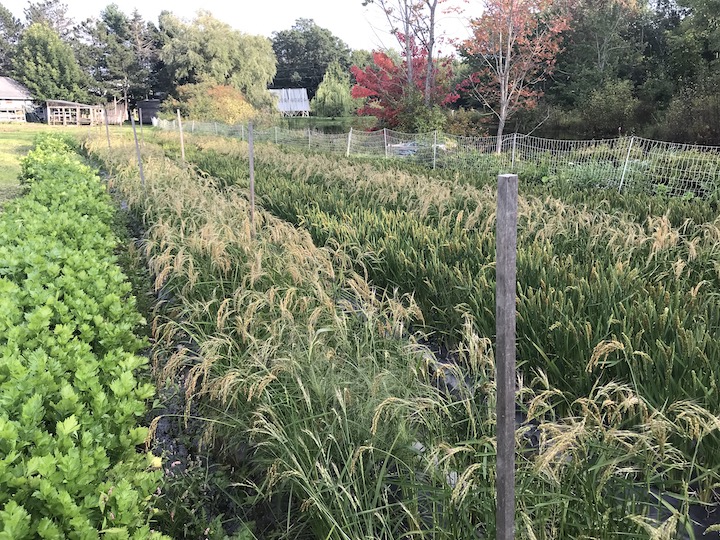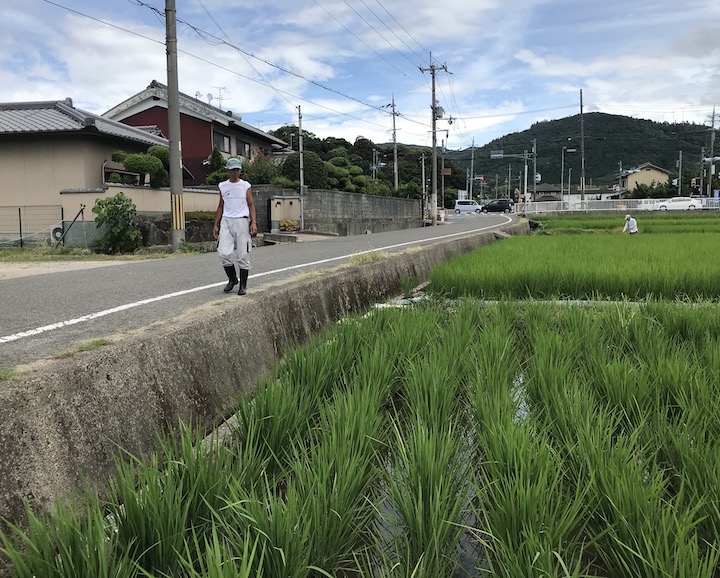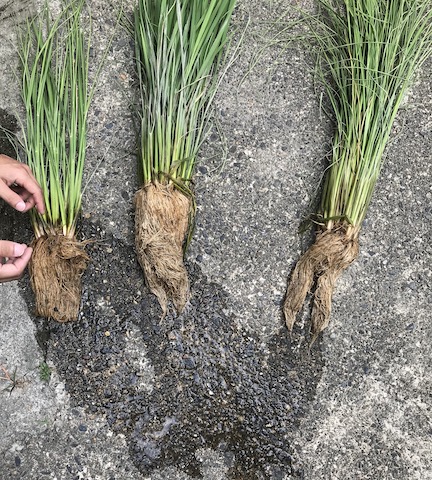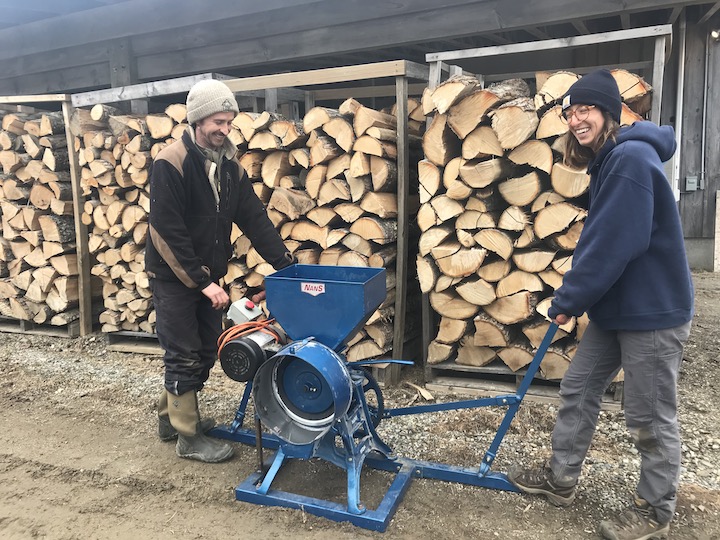By Ben Rooney
There have been plenty of highs and lows during my 10 years of rice production in Maine. In fall 2020, I was feeling dispirited with hard freezes in June and mid-September and yet another dry summer. My paddy system at that time was based on climate change models from 2010, which, following the patterns from 1990 to 2010, predicted more rainfall and precipitation in our region during the growing season, not less. Furthermore, the water budgets for the paddy system only factored in surface water, not underground hydrology.
A few years back, through a Maine Technology Institute Seed grant, I received training and assistance from a professional soil scientist and hydrologists to better equip myself to analyze the water budget at specific locations and determine what type of rice production (lowland or upland) could work best. The primary soil hydrologist I worked with taught me that, at certain locations, analysis can be fairly accurate in finding reliable sources of stored underground water. Even with more dry summer weather, water tables across New England are actually going up, and one reason for this is we still get plenty of precipitation outside of the growing season. I learned that if you have a decent size watershed uphill and well percolating soil, or even just a narrow channel of it, you might have a lot of water storage to call upon. Methods for retrieving this groundwater include a new U.S. Geological Survey shallow well design, terracing, or building a rice paddy.
The Maine Rice Project at Ararat Farms
The Maine Rice Project is now located at Ararat Farms in Lincolnville. Unlike the heavy clay soils of Benton, where I first grew rice, Ararat Farms has sandier, rockier soils, in a mix of wet and dry environments.
Last year I decided to focus more on upland rice, as these grains don’t mind deluges of water and can tolerate drier spells. In my first year at Ararat Farms, I wanted to start small, and I grew about a quarter acre, split between a paddy, a wet field, and a dry field perched atop a ridge. I trialed 12 different types of upland rice, many at multiple locations; what a great learning experience!

The upland rice was irrigated with drip tape and then mulched soon after. Many farmers I sell rice seed to use black plastic or landscape fabric, so in the newly cultivated wet field, which had heavy horsetail pressure, I compared landscape fabric and straw. I didn’t find any significant difference between the rice yields. The best rice grew in the paddy, which yielded about 4,000 pounds per acre, the wet field yielded 3,000 pounds per acre and the dry field yielded 1,000 pounds per acre.
In the upland rice realm, I was quite happy with how well the wet field rice performed. I do not think it is worth growing rice in dry/normal fields, unless summer precipitation in Maine becomes more consistent and wetter. While a wet field doesn’t need to have standing water, there are scenarios to consider for a good harvest. Like most crops in the vegetative stages, rice roots are adaptable and dynamic and, when healthy, can send their roots down deep for water or nutrients. However, during the reproductive phase, which starts in late July, the plant switches energy and focus to the seed head and away from the roots. Furthermore, the rice needs a good amount of water for seed fill in mid-August. So if June is really wet but August is bone dry and the water table drops a lot, the seeds might not fill in (a common issue I hear from growers I have sold seed to). A soil probe can help determine where the water table is and how much it fluctuates seasonally. Overall, soil probes work wonders for underground analysis of a site.
In 2021, I intentionally let the rice dry out some during this stage to encourage root growth. This deeper root growth also helps the rice withstand lodging (falling over). The other option is to just grow the rice in areas that are perpetually wet.
Lessons from Japan
As I learned on a trip to Japan in 2018, rice actually likes loamy, sandy (well-drained) soil as long as they stay wet! Most of the paddies there resemble cranberry bogs, with lighter soil in the first 2 feet and a heavier clay layer below. Some paddies were sand all the way down. On this mountainous lush island, huge rivers have been diverted, and irrigation and water supply aren’t currently an issue.
The small-scale organic rice community in Japan is surprisingly small. I first visited my inspiration for rice farming, Takao Furano, author of “The Power of Duck.” Here I saw 14 acres of paddies amongst which 1,400 happy ducks ranged. The other highlight came at the end of the trip. On a tip from an obscure source outside this tight-knit rice community, I decided to check out a rice farm not in the countryside, but right in the heart of Nara, Japan’s first capital.

Masayuki Kido, an elder, was as humble as they come, didn’t own a car, and biked between his dispersed paddies intermingled in a mosaic of cityscapes and other rice plots. Immediately upon seeing the greenest and bushiest rice plants, I knew there was something special afoot.
I stepped into a paddy and buried my hand beneath the water and into a loose soil matrix with a huge network of rice roots. Kido attributed his success to three main things.

1. Methodical seed saving. The rice is raised in a nursery where the water level is incrementally lowered to increase root branching and elongation. During transplanting, the seedlings with the best roots (and often the biggest shoots) are chosen as potential seed stock. Of those best plants, seed is saved from the second and third tallest panicles (stalks with rice seeds on them), a small fraction of seed per voluminous plant.
2. The power of the snail. Numerous species of snail troll the ground between the rice plants. Similar to ducks, they excrete fertility and disturb the paddy floor, creating a murky environment in which weed establishment appeared quite difficult! Kido said his neighbors use pesticides and claim the snails a nuisance, calling some “invasive.” Kido, beating to a different drum than his neighbors, reminded me of Japanese farmer and philosopher Masanobu Fukuoka, the well-known author of “The One Straw Revolution,” in his simple yet intentional path to grow rice in tune with the natural environment.
3. The holy mountain and planting cycles. Kido said in 25 years of farming he has yet to use inputs. He ascribes some of this success to his lunar-based planting calendar and more to the holy mountain, within eyesight, that is the water source for the paddies. Not to discredit any of this magic, but in hiking in the mountains in Japan one can see the limestone and abundant calcium and minerals eroding into the waterways … That sounds pretty holy to me!
“Where did you learn so many particular, and sometimes fastidious, techniques?,” I asked him. The seed saving and snails were completely novel to me. Kido answered that when he started farming rice he wanted to do it traditionally but had no one to turn to. (After World War II Japan quickly modernized in many areas including rice production). He went to archives deep in Tokyo’s national libraries and read of practices of yore. Twenty-five years later, Kido’s acre of rice is one of the last vestiges of traditional rice farming. Only in the past few years has it come to his attention that he has something very special. He also had the yummiest rice I ate in Japan, and he likes to host work parties.
Equipment Updates
If you decide to grow rice (or other grains), the Maine Rice Project, in conjunction with the Maine Grain Alliance, has you covered for your small-scale processing needs! With the support of a Maine Agricultural Development Grant, we imported five CeCoCo-type impact hullers from India. They have since been tested and modified, and currently work well for rice and some other hulled grains.
Three of the hullers are available for public rental/use. They are mobile and can fit in the back of a truck. All can run on human power and two have motors attached.

Each machine can hull hundreds of pounds of rice an hour. We are also ordering a winnow wizard — a simple and amazing seed cleaning machine — to go alongside two threshers, and a few other antique winnowers and seed cleaners.
Hopefully some of this equipment will be at the Common Ground Country Fair in the future, as well as other locales for easy public use. You can contact the Maine Rice Project about using or renting this equipment. For larger-scale processing, the Maine gristmill is a better option; their minimum batches are in the thousands of pounds.
This article was originally published in the summer 2022 issue of The Maine Organic Farmer & Gardener.
